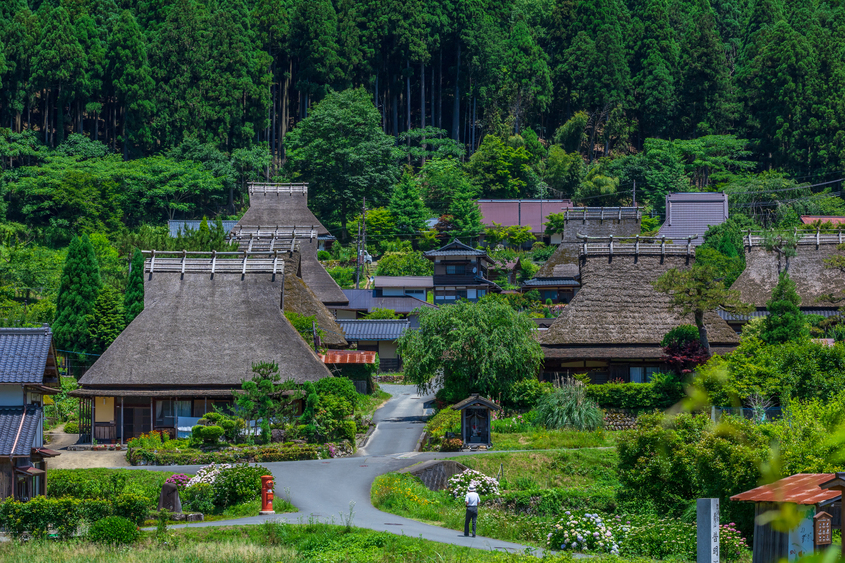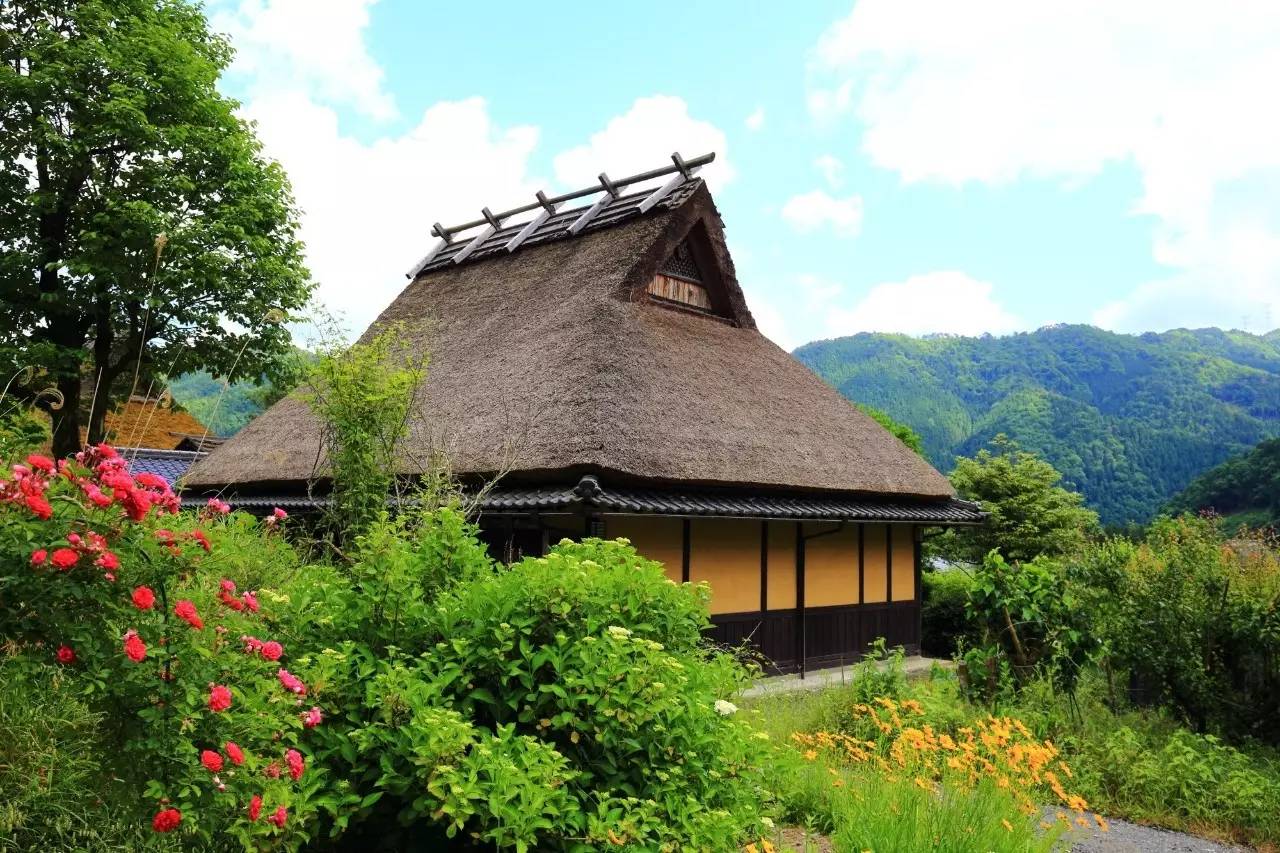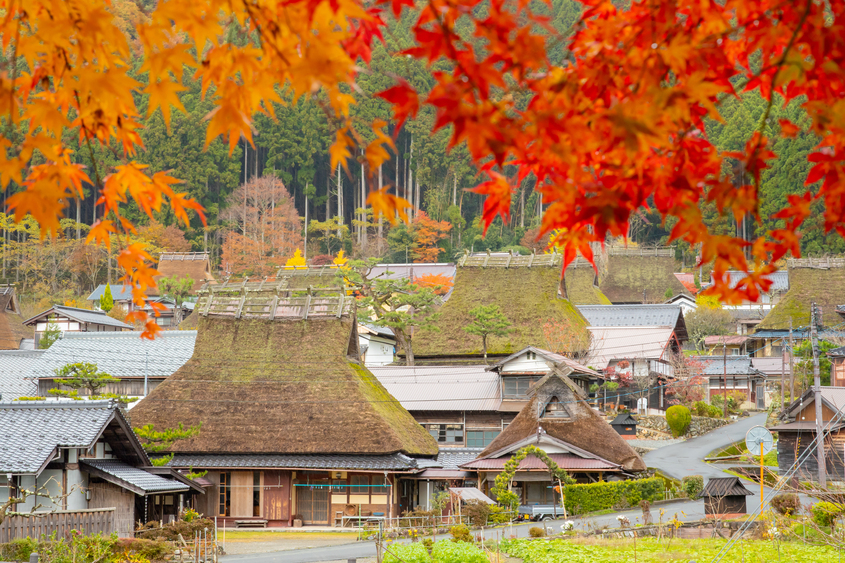Miyama Village

Miyama Traditional Village
Miyama is located 30 kilometers north of the center of Kyoto and is renowned as one of Japan's top three famous thatched house areas - Gassho Village in Shirakawa-go and Ouchi-juku in Shimogo Town.
Miyama Thatched-roof Village in Kyoto boasts over 250 preserved thatched huts and was designated as an "important traditional settlements preservation area" by the Japanese government in 1993. Thus, it epitomizes the most authentic Japanese rural style. The entire Miyama Town is composed of several villages with about 3,500 residents.
What sets Miyama apart is that these houses are not merely for sightseeing purposes; they are still inhabited by residents. It is this aspect that contributes to its fame. One of the villages in Miyama Town is also known as Kayabuki no sati. There are nearly 40 farmhouses with thatched roofs in this village. Visitors can stroll around the village, but here too, most houses are private homes that cannot be entered. Almost every household has a garden and vegetable patch. They live a self-sufficient life and still retain the original style of Japan. Those who have visited Miyama sincerely express their admiration, saying, "To live in such a beautiful place is a truly blissful life."

Things to do in Miyama
1. Kayabuki no Sato Folk Museum
One of the buildings open to the public is the Kayabuki no Sato Folk Museum. It is dedicated to preserving and displaying the cultural heritage of this tradition. The museum houses thatched cottages and associated buildings that visitors can explore and learn about their structure, history and cultural significance. In addition, the museum provides information on the making and maintenance of thatched houses, as well as displays of Japanese rural life and artifacts associated with this architectural style. Visitors can experience traditional Japanese rural culture first-hand here, including tours of thatched houses, tea ceremony performances and handicraft making.
2. Little Indigo Museum
Little Indigo Museum focuses on the display and inheritance of indigo dyeing art and culture. Indigo dyeing is an ancient dyeing technique that uses indigo to extract dye from natural plants to dye cloth blue. At the museum, you can watch indigo dyeing artists perform practical demonstrations of the indigo dyeing process. These demonstrations usually include the preparation of dyes, handling of cloth, and the dyeing process. The museum encourages visitors to participate in interaction and provides some indigo dyeing workshops and experiential activities, allowing visitors to try indigo dyeing techniques themselves and make their own indigo dyeing works.
3. Kayabuki no Sato Snow Lantern Festival
Usually held in Februry every year, the festival’s illumination will begin from 5 p.m. to 8 p.m. The main highlight of this celebration is the art of snow lanterns and snow sculptures, where local residents use snow to make snow lanterns and sculptures of various shapes and styles. The pieces include lanterns, animals, flowers and other decorations, often placed in courtyards, riverbanks and along streets to create a fairytale winter landscape. Celebrations usually include some traditional Japanese cultural performances such as folk dances, music performances and traditional plays to enrich the activities. Visitors can taste local specialties and hot drinks, while also having the opportunity to buy handicrafts and souvenirs.

4. Traditional home stay in thatched-roof farm house
There are several types of accommodation in Miyama Town, including original thatched houses, local farmhouses, Japanese-style B&Bs, youth hostels and hotels. Among them, the original thatched cottage is particularly eye-catching, attracting tourists from all over the world with its unique design and original ecological atmosphere. Lodging in a thatched roof traditional Japanese farm house is a unique stay experience, which allows people to escape the hustle and bustle of the city and immerse themselves in the beautiful natural environment and peaceful atmosphere, while enjoying delicious food and the opportunity to participate in traditional activities.
5. Watering Ceremony
Little Indigo Museum focuses on the display and inheritance of indigo dyeing art and culture. Indigo dyeing is an ancient dyeing technique that uses indigo to extract dye from natural plants to dye cloth blue. At the museum, you can watch indigo dyeing artists perform practical demonstrations of the indigo dyeing process. These demonstrations usually include the preparation of dyes, handling of cloth, and the dyeing process. The museum encourages visitors to participate in interaction and provides some indigo dyeing workshops and experiential activities, allowing visitors to try indigo dyeing techniques themselves and make their own indigo dyeing works.
6. Miyama no Megumi Milk Studio
If you want to experience the delicious food of Miyama, don’t forget to take some time at Miyama no Megumi Milk Studio to enjoy the delicious Miyama milk ice cream. The cream puffs here are also very popular, and they are definitely worth buying and tasting, because you can’t buy them again after leaving Miyama.It’s very famous in the local area.
7. Furatto Miyama
It is the largest supermarket in Miyama Town. If you want to buy some souvenirs, you must take a stroll here, the variety is very complete. There are various agricultural products produced by Meishan, such as Meishan milk, Meishan rice, Meishan eggs and various vegetables. The price is a bit expensive, but it is very famous. You can’t buy them anywhere else in Japan!
8. Kyoto Tamba Kogen Quasi-National Park Visitor Center
Just opposit the supermarket, Kyoto Tamba Plateau Quasinational Park Visitor Center provides English services to the visitors all over the world. From April to November, you can also rent an electric bicycle e-bike, which costs 2,000 yen for 4 hours and 3,000 yen for one day. It also offers reservation services of farming experience or homecooking.
Recommended tour package with Miyama Village:
7 days Osaka, Kyoto, Lake Biwa, Funaya and Amanohashidate tour package

